The 2012 MacBook Air (11 & 13-inch) Review
by Anand Lal Shimpi on July 16, 2012 12:53 PM EST- Posted in
- Apple
- Mac
- MacBook Air
- Laptops
- Notebooks
The Display
The MacBook Air is really Apple's mass-market notebook, and as such it's not going to be the target for a Retina Display upgrade, at least not this year. While technically feasible, my guess is a lack of supply kept a rMBA out of the cards for this year. There's also the matter of maintaining its thin profile and battery life in pursuit of a retina display.
The MacBook Air display continues to be good, and better than most, but no where near what the rMBP delivers and actually a step behind what the competition in the PC space has been cooking up.
If there was one clear trend at Computex this year it's towards IPS 1080p displays in Windows 8 notebooks. ASUS actually pre-empted all of the exciting announcements (rMBP included) with its Zenbook Prime, complete with 11 and 13-inch 1080p IPS displays. As the MacBook Air retains its TN display, for the first time we can actually say that ASUS' Ultrabook offers better viewing angles than the Air. The difference is quite noticeable:
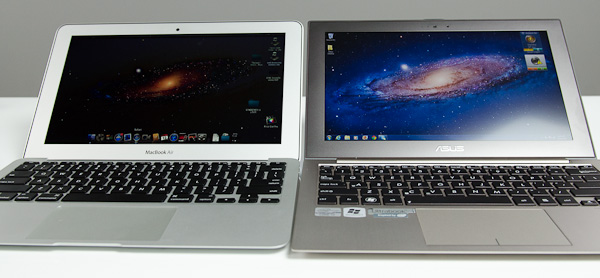
2012 MacBook Air (left) vs. 2012 ASUS Zenbook Prime (right)
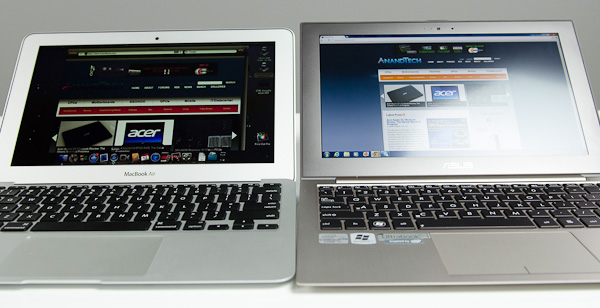
2012 MacBook Air (left) vs. 2012 ASUS Zenbook Prime (right)
ASUS also enjoys a resolution advantage, but it's not really high enough to make good use of integer DPI scaling (at 2x you get a UI sized for a 960 x 540 display). You get sharpness, and additional desktop area, but not the total package you get with the rMBP. There's no denying that what ASUS has done is better, it's just not perfect. And as Apple has shown us in the past, it's not fond of stopgap solutions.
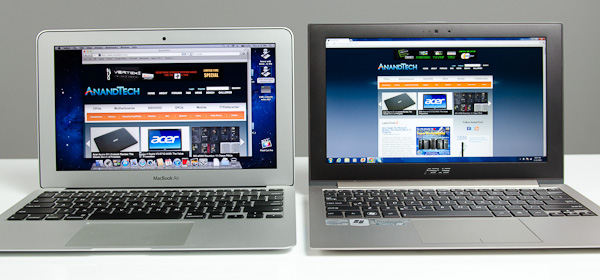
2012 MacBook Air (left) vs. 2012 ASUS Zenbook Prime (right)
Brightness, black levels, contrast, color accuracy and gamut haven't changed over the past year. The MacBook Air's panel remains one of the best non-IPS solutions on the market. The problem is that consumer insistence higher quality displays has pushed Apple's competitors to finally deliver more than TN at MacBook Air price points. Sooner rather than later, Apple will have to respond.
The Panel Lottery
Unlike in previous years, there appears to be three manufacturers supplying panels for the 2012 MacBook Air. LG Philips and Samsung return from before, but AUO now joins the fray. It's quite possible that Apple's volumes have grown large enough to justify adding a third supplier - a trend we may see increase in the future, and across more component categories.
As always, you can try to find out what panel is used in your MacBook Air by executing the following command in an OS X Terminal window:
ioreg -lw0 | grep IODisplayEDID | sed "/[^<]*</s///" | xxd -p -r | strings -6
The output will look something like this:

As long as Apple hasn't masked the data, the first line should be the part number of your display panel. The first one or two characters will tell you the manufacturer: LP for LG Philips, LT for Samsung and B for AUO. Anecdotally, LG and Samsung seem to be the most prevalent. In my personal experience with six 13-inch 2012 MacBook Airs and three 11-inch MacBook Airs, the breakdown was as follows:
13-inch $1499 - Samsung
13-inch $1499 - Samsung
13-inch $1499 - Samsung
13-inch $1499 - Samsung
13-inch $1499 - Samsung
13-inch $2199 - LG
11-inch $1099 - AUO
11-inch $1099 - AUO
11-inch $999 - Samsung
A thread over on Macrumors places the Samsung/LG split much closer to 50/50, however it's not clear if there's a higher incidence of LG panels in BTO or non-default configurations. We'd need many more samples to really get an idea for how all of this shapes up, so don't put too much faith in the results from my experience.
Apple does its best to ensure that all three panels deliver comparable performance, however there are differences. Let's first start with the numbers:
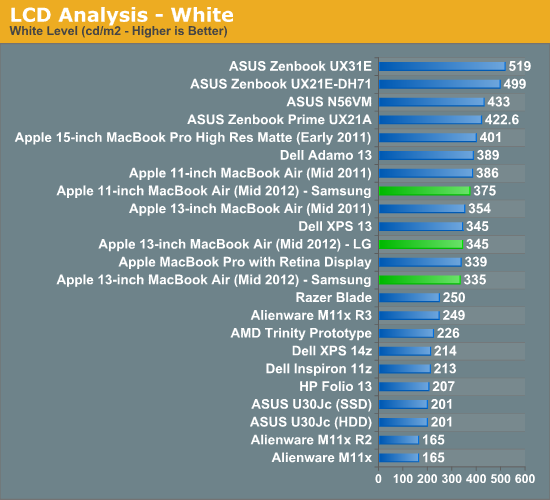
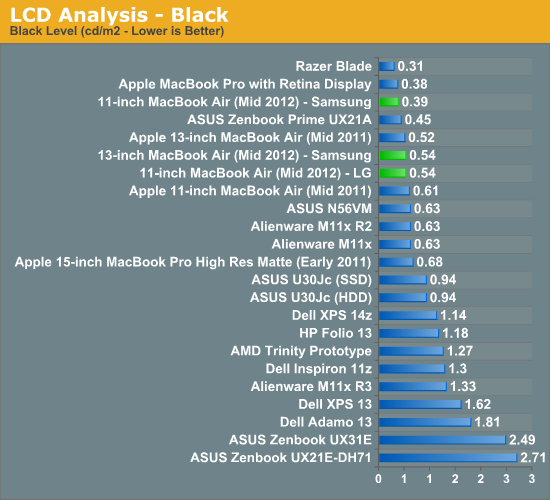
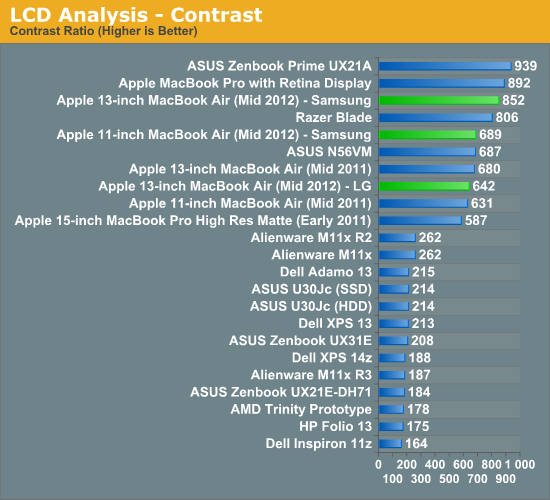
The 13-inch LG panel delivers tangibly worse black levels than the Samsung alternative. There's even a pretty dramatic difference in black levels between even the 11 and 13-inch Samsung panels. It's also possible that there's panel to panel variation at play here that would result in this sort of a difference.
The LG panel is a bit brighter, which helps it reach a decent contrast ratio but the 13-inch Samsung panel's low black levels give it an advantage. Interestingly enough, the 13-inch LG sample performed very similarly to the 11-inch Samsung. I really do wonder how much of this difference is just normal variance between panels.
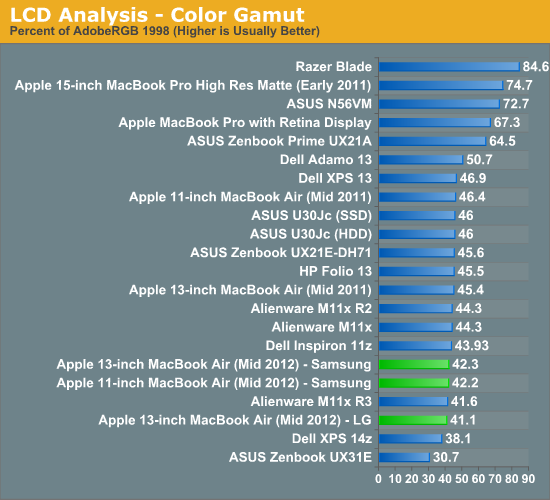
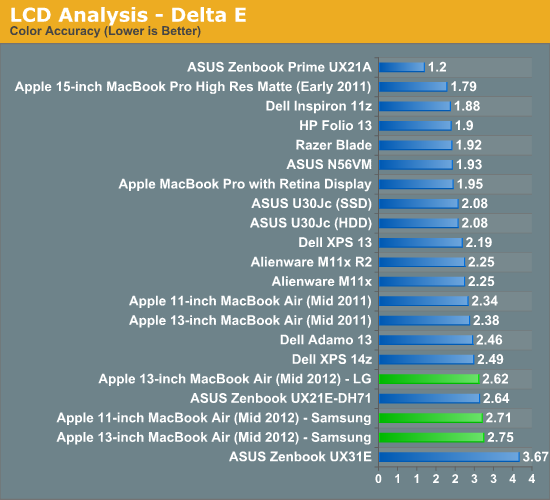
Color accuracy is slightly better on the LG panel, although it's not beyond the noticeable threshold. Color gamut is comparable between the displays.
Independently, neither the Samsung or LG panels is particularly bad to look at. These are still TN panels so you get poor vertical viewing angles, but the quality is still better than the cheaper TNs we often see used in less expensive notebooks. It's when you compare the two or you're used to one that you can really tell a difference: the Samsung panel, particularly when displaying black text on a white background, looks better than the LG.
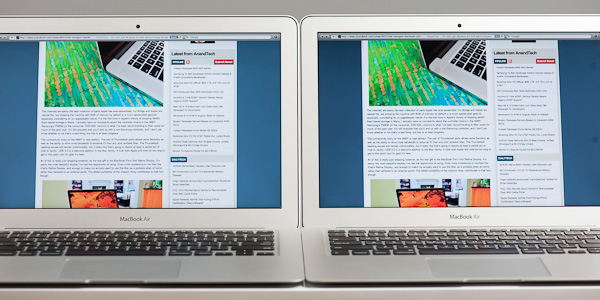
13-inch LG LP133WP1-TJA3 panel (left) vs. Samsung LTH133BT01A03 panel (right)
I had some friends over and tossed them a pair of 13-inch MBAs. One had the LG panel and one had the Samsung panel. They used the MBAs and swapped after a short while. Almost instantaneously they could tell the difference between the panels. Everyone significantly favored the Samsung.
I was actually a bit surprised how quickly they noticed the difference. With these type of things I always assume I'm just more sensitive than most, but in this case the difference was noticeable enough to pick out. Everyone added (and I agreed) that the difference was most pronounced because they were able to switch between two. In a vacuum each one seemed fine.
I tried my best to capture the difference between the two panels on camera. The easiest way to describe the difference is text on the Samsung panel just looks darker (mouse over the panel name in the table below):
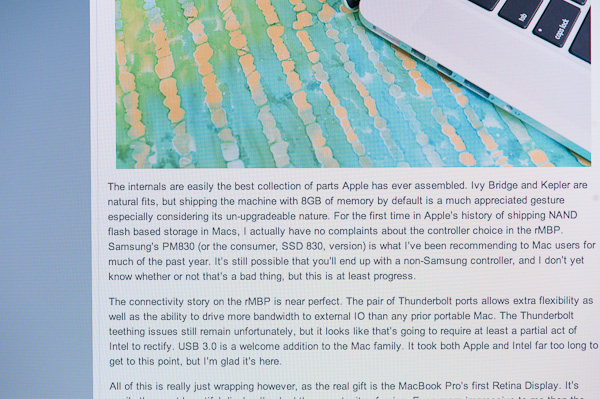
| LG LP133WP1-TJA3 | Samsung LTH133BT01A03 |
| original | original |
Just like last time, I believe the two panels behave differently in how they react to off-center viewing angles but I couldn't really capture the slight differences on camera. Although I didn't have an AUO equipped MBA on hand, the one I saw in an Apple store looked closer to the LG than the Samsung.
The good news is after a calibration pass using Color Eyes Display Pro, the difference between the two is significantly reduced - to the point where I can no longer tell the two apart:
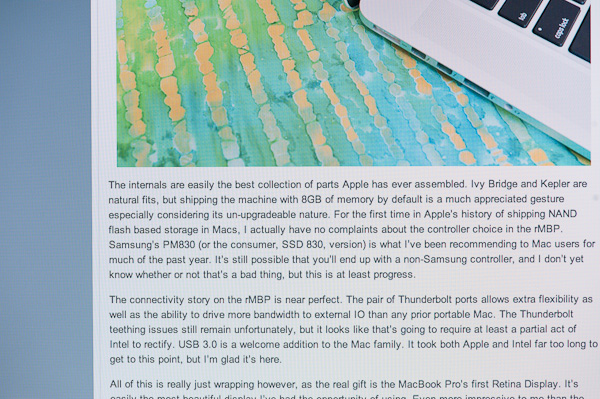
| LG LP133WP1-TJA3 | Samsung LTH133BT01A03 |
| original | original |
The obvious problem with this solution is you need access to a decent colorimeter or spectrophotometer and calibration software. There are some color profiles floating around the web that may help (I've uploaded mine for the LG here, Samsung here) but every panel is going to be at least somewhat different so this is still not perfect.
Subjectively, I'm fine with the LG panel, although I do like the look of the Samsung better. Both are a bit of a disappointment compared to what you get from the Retina Display in the MacBook Pro however. It's just presently what you give up for portability and cost.
To Make a Retina
The thing about the MacBook Air is that it's already quite minimized on the inside. The vast majority of the chassis is occupied by a battery, and there's no traditional HDD or optical drive to remove for additional space. Apple can't simply toss a much higher resolution panel on the system and call it a day, at least not without a tangible reduction in battery life.

13-inch MacBook Air (Mid 2012) - iFixit
Apple had to give the MacBook Pro with Retina Display a 95Wh battery (up from 77.5Wh) just to deliver similar battery life to the regular MacBook Pro. The higher resolution display requires a brighter backlight to push light through the panel and maintain comparable brightness levels.
The motherboard itself can stand to lose a single chip (the PCH) with the transition to Haswell, but that's not going to give us a ton of space either.
In the short term Apple could opt for a slightly thicker chassis (similar to what happened in the 3rd gen iPad) to accommodate a larger battery. Eventually the hope is that panel efficiency will increase to the point where we won't need significantly brighter backlights.


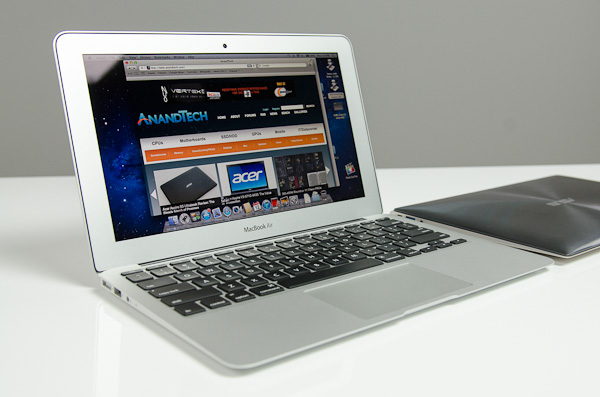








190 Comments
View All Comments
EnzoFX - Monday, July 16, 2012 - link
but it's so cool to hate apple! Some people just can't stand when Apple has the overall better package. The thing I don't get with these haters is that they never, ever understand half the story. They get caught up in specs, they don't see that Apple consistently has solid drivers and software that other's solutions pale by comparison. Take touchpad drivers, they are still hit or miss, and not as good as Apple's Laptops. Those easy to get going apps? Well what do you think the average consumer wants? Actually, who doesn't want easy to set up? What good is an amazing camera if it has a cumbersome application to go with. I'm not saying one thing is more important than the other, just that it's all about the overall package, people like him clearly miss the more important components of it.Sunburn74 - Monday, July 16, 2012 - link
Its not hating apple. More like how an increasing number of reviewers walk in with pre-established beliefs concerning apple and those subconcious beliefs are evident in their writing. Its kind of like having a thing for blondes and then being a reviewer of good looks at a modeling contest. You can try your best to be perfectly objective, but geez your preferences will come out, especially to people who don't give a care about hair color or even more so to people who prefer brunettes and etc.Anand may not believe it (the people on engadget as well, and the verge is horribly pro apple), but he has pre-determinined beliefs about apple (like we all do) which come out in his writings. Just think about it like this. Anand's primary machines are macs. If he were to say mac's are crap, he'd be slighting himself in a way. I realize saying macs are crap are the extreme, but the point is the same. Saying something negative about apple is saying something negative about himself.
KPOM - Tuesday, July 17, 2012 - link
It's true the other way, though. Read the Macalope column in Macworld and you'll see examples of some of the nonsense put out (Katherine Noyes is a frequent target).Anand is pretty upfront that he uses Apple devices. However, he did point out the weak spot in the 2012 MacBook Air, which is that the display hasn't evolved along with the rest of the device. Otherwise, it's hard to argue with their choice of components. The keyboard and trackpad are still top notch (only now, about 4 years after Apple, are Windows OEMs starting to get multitouch trackpad drivers running smoothly, for instance). The SSDs are Samsung or SandForce based (in line with the industry). They are offering 256GB and 512GB SSD capacities (which are rare), an 8GB RAM option, and the 2.0GHz Core i7 option (many others are topping out at 4GB and the 1.7GHz or 1.9GHz i7). The camera and wi-fi components are competent. Objectively, it is difficult to argue that the MacBook Air isn't one of the higher end ultraportables.
mavere - Monday, July 16, 2012 - link
Anand states that the MBA is a top-tier competitor in the ultrabook market. Unless you care to refute that conclusion, the obvious implication is that Good >> Bad, which was the exact tone of the review.Five pages of bashing trivialities and concluding with "oh I guess this is one of the best products in its category" (not exactly a controversial statement here) would have served no one.
Freakie - Tuesday, July 17, 2012 - link
Yet other Anandtech writers do EXACTLY that. They will nit-pick over very many small "trivialities" but they will not go and use them to say that it is a crap product. There is a difference between objectively reviewing a product and then acknowledging its stance in the market, be it one of the best or one of the worst, and writing like a fanboy.Galatian - Monday, July 16, 2012 - link
On a side note I actually also did not see any improvement in camera to my MacBook Pro 15" from 2008 which was still the normal "SD" quality...then again I never used it for anything anyway...I just checked out: I do have the Samsung screen but Toshiba SSDs...The boot time IS amazing. Being able to work within 20s from pushing the button is invaluable to me, not that i got used to working my new Air.
By the way Anand: Am I just stupid or did you say you were going to post the screen profiles?
GotThumbs - Monday, July 16, 2012 - link
I totally agree.Objectivity and Independence is missing in this "Review".
Endorsement is more like it " buy the 11."
I've been Reading this site for over 9 years. Very disappointed with Anand.
uhuznaa - Monday, July 16, 2012 - link
Well, either Anand is mutating into an Apple fanboi or these things are really just good. Judging from the benchmarks and the pure facts (as well as my own limited experiences) I tend to the latter.[BTW, what's up with the login here? Neither Chrome nor Firefox are able to save and restore my password here. This really is getting on my nerves since I use strong, unique passwords everywhere and looking it up every fscking time I want to post a comment is somewhat uncomfortable.]
EnzoFX - Monday, July 16, 2012 - link
Works with 1Password =p.Anand Lal Shimpi - Monday, July 16, 2012 - link
The FaceTime HD camera in the MBA appears to be one of the best out there, at least in what I've seen compared to most notebooks. My point wasn't to balance out the negative, but rather put it in perspective. The comment about needing good lighting applies to every single integrated webcam shipping in a notebook today.The same for WiFi. The MBA's WiFi is competitive with everything else in its class, no one offers anything better in this chassis size while many offer something worse. Until recently many Ultrabooks were still shipping 1x1:1 configurations. The 3x3:3 setup is just something you get when going to the more expensive Pro models.
The real disappointment here is the display, not in that it's bad but that it's not as good as the new bar set by the ASUS Zenbook Prime.
Take care,
Anand